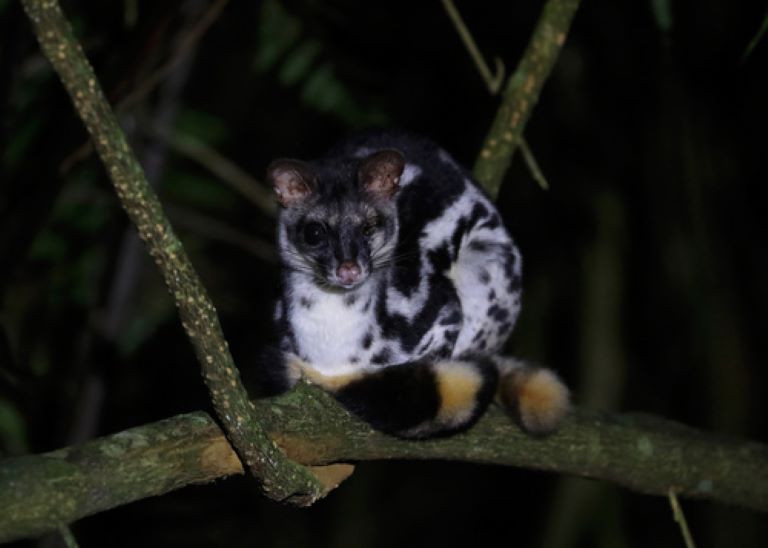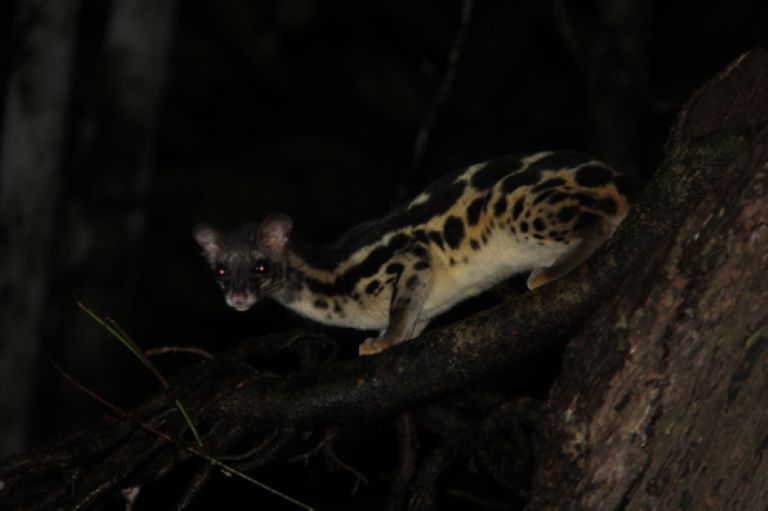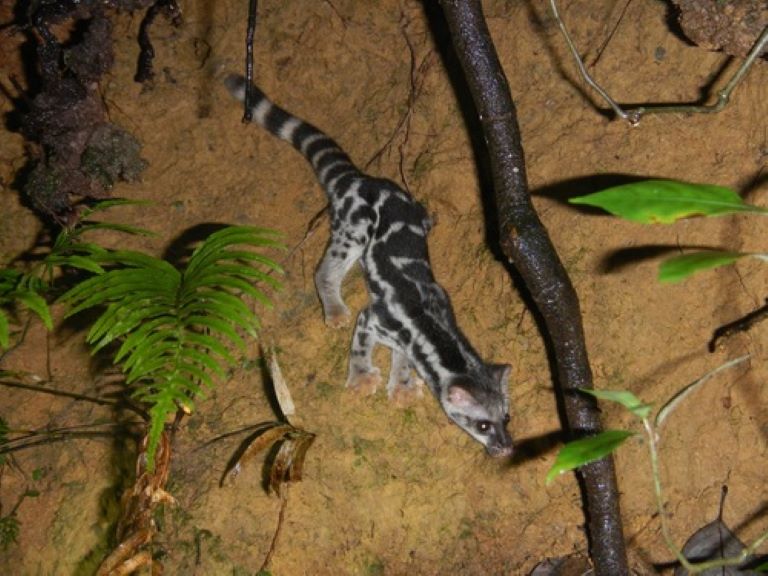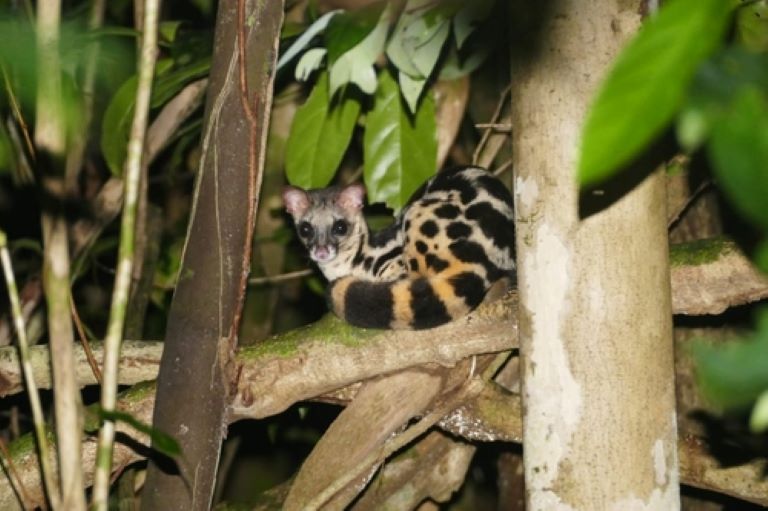Asiatic Linsang Profile
Southeast Asia is one of Asia’s most densely populated subregions, with populations expanding all the time, and often wetlands and forests are being sacrificed to support this.
Yet, there are still countless species, many of them large and elusive, that live in these ecosystems and have yet to be understood, or even captured on camera across most of their range.
The Linsangs are one example of this; an unusual animal, somewhere between a feline and a viverrid, with two species known, but so exceptionally secretive that almost nothing is known about them.

Asiatic Linsang Facts Overview
| Habitat: | Lowland forest |
| Location: | South and Southeast Asia |
| Lifespan: | Unknown |
| Size: | 43 cm (17 in) head and body length, with a tail of around the same. |
| Weight: | Up to 700 g |
| Colour: | Golden brown with darker bands of spots |
| Diet: | Not clear; highly carnivorous |
| Predators: | Unknown |
| Top Speed: | Unknown |
| No. of Species: | 2 |
| Conservation Status: | Both are of Least Concern (IUCN) |
Linsangs are unusual forest carnivores. Long, agile and elegant predators, spanning a wide range across Southern and Southeast Asia, there are only two species known in the family, having been identified as distinct from both the felids and the viverrids they resemble.
But this may not be all; not a lot is known about them and while one species is barely studied, the other hasn’t got any field research to its name, so the genus could have some more surprises in store in the future.
Interesting Asiatic Linsang Facts
1. They’re half cat, half genet
This isn’t taxonomically accurate, though their obvious similarity to both genets and cats was enough for them to be grouped as such in the past.
They were originally grouped in the genus Felis and moved to the Viverridae family in 1864 when scent glands were discovered that indicated them to be closer to genets.
It was fairly recently that genetic taxonomists deciphered these strange animals’ connection with the Felidae family and confirmed that they aren’t Viverrids after all.
But they’re not cats, either, but a sister-taxon for the Felidae family, and not closely related to genets at all, despite their appearance.
Interestingly, the African linsang of the same name is indeed related to the genet, being a much more recent sister group to the genus Genetta.
So, while the African and Asiatic linsangs look like the same middle ground between genets and felids, they’re actually unrelated branches of one and the other, respectively. 1

2. There are two species
Asiatic linsangs form only two known species in the genus Prionodon. Banded linsangs are the heavier of the two, growing to around 40 cm long without the tail, which is almost as long again. This one is so named for the dark bands on its pale-yellow body and is found over much of Southeast Asia.
The spotted linsang is an ironic name for something so hard to see, and looks much like the banded linsang but can be darker in its base colour and has rows of spots running down its back. Like the banded, it has rings down its thick, cylindrical tail, which is more or less as long as its body.
But this is a lighter animal than the banded linsang, at around 450 grams. It’s also found in Southeast Asia, but on the mainland, and extends farther North into China and across into Nepal and Bengal.
Both are nocturnal and rarely observed at the best of times, but in regions with the lowest density, they’re almost legendary.
3. They are elusive
Spotted Linsangs are so rare that the simple act of catching one on a camera trap can land you a published article in the Journal of Animal Diversity, just as it did in 2022 when a small team published a paper with their results: two photos of the secretive animal in the Tashigang Forest Division of eastern Bhutan – one at 2,308m altitude, the other at 2,952 m, and the first such evidence of the species in this region.
The paper quite manipulatively refers to it as “…among Asia’s least studied members of the family Prionodontidae”, deliberately ignoring the fact that there are only two members in this family, and if the spotted linsang is not studied much, the banded linsang is almost mythical to science. 2

4. Banded Linsangs have never been studied in the wild
Banded linsangs have never been successful subjects of field research. This is a phenomenal claim for such a relatively large animal and is a testament to its ability to remain hidden.
But it’s also troubling because while they are considered Least Concern by the IUCN, all the information about them is dubious at best; relying on inferences from other species or general ecological principles.
Locals spot them, and surveys have concluded their presence in both primary and secondary forest but the sampling bias for this sort of research will skew the data towards more accessible habitats.
There is some evidence from the stomach contents of hunted specimens that they are found often at the edges of forests or in disturbed areas, but this is still primarily a matter of guesswork. 3
5. They’re probably in decline
It’s become safe to say this about almost anything that typically resides in a tropical forest, but there’s a little more to go on than general trends for the decline of the Asiatic linsang.
The habitats of the banded linsang are being converted at a terrifying rate from pristine forest to pasture, mining, or palm plantations. In areas where this destruction is slowing, that’s in large part because there’s almost nothing left already.
But there’s hope in the linsang’s ability to tolerate high altitudes – areas which are the last to be destroyed by people.
So far, the expected decline in this linsang’s habitat isn’t thought to be significant enough to threaten the species as a whole, and at least it’s not as terrible as was once thought.

6. But it’s not as bad as was once thought
While researchers struggle to find them, the local hunters who live in the forest have more luck.
Linsangs are hunted and traded across various borders in Southeast Asia, and coupled with the habitat destruction, this was once thought to be enough to deem them threatened.
It appears that while linsangs are taken by snares, their elusive nature has kept them mostly under the radar in terms of the market for their meat – they’re seen seldom enough that even the people living alongside them don’t know or care about them all that much.
Further, the seeming lack of impact that habitat fragmentation is having on their rate of capture suggests that they’re adaptable enough to tolerate this, at least for now.
So, the report from 1989 that rendered them Vulnerable has been overturned and deemed overly pessimistic, which is great news for the linsangs if true, though it must be emphasised that these secretive animals are still very poorly understood.
Asiatic Linsang Fact-File Summary
Scientific Classification
| Kingdom: | Animalia |
| Phylum: | Chordata |
| Class: | Mammalia |
| Order: | Carnivora |
| Family: | Prionodontidae |
| Genus: | Prionodon |
Fact Sources & References
- Philippe Gaubert (2003), “Exhaustive sample set among Viverridae reveals the sister-group of felids: the linsangs as a case of extreme morphological convergence within Feliformia”, Royal Society Publishing.
- “Spotted Linsang”, IUCN Red List.
- “Banded Linsang”, IUCN Red List.
